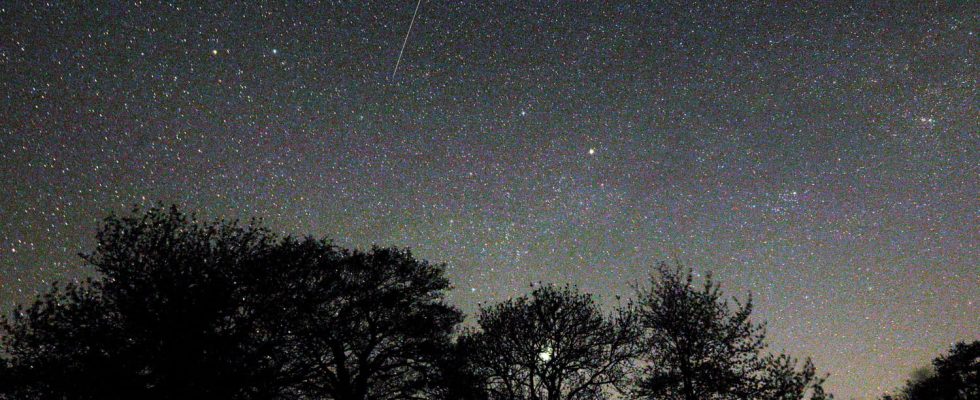SHOOTING STARS. In April, we will not miss the phenomenon of the Lyrids observable until April 30, 2023, and whose peak of activity takes place on the night of April 23. How to observe them and what does a shooting star mean?
[Mis à jour le 14 avril 2023 à 17h11] Until April 30, 2023, the meteor shower of the Lyrids promises a magical spectacle in the sky. It is one of the most beautiful meteor showers of the year and also one of the oldest astronomical phenomena observed, 2,700 years ago. To observe the Lyrids, look up at the bright star Vega, located to the northeast in the constellation of Lyra.
The Lyrids are active until April 30, every night from midnight, visible until dawn. Then will come the meteor shower of the Eta Aquarids, visible in the sky at the beginning of May, then the star of the year, the Perseids, in August. Here is everything you need to know about the famous Lyrid rain, its definition, its observation, as well as the program for the year in terms of shooting stars.
These are dust grains from comet C/1861 G1 Thatcher, discovered in 1861, which fall on the Earth’s atmosphere when the Earth passes through it. Located in the constellation Lyra and active from April 14 to April 30, the Lyrid meteor shower experiences, according to the site Starwalk, a peak on the night of April 23, with a rate of 18 observable meteors per hour.
Until April 30, 2023, it is possible to observe the Lyrids, from midnight until dawn. Indeed, the light of the Moon will not interfere with the observations “because it will be a thin crescent during the peak of the rain”, explains the site Starwalk. The brightness should not interfere with the observation of the most visible meteors, especially if you manage to be far from city centers or points of light. When you see a meteor, multiply your wishes, a well-known tradition!
Find below all the essential advice for good preparation and good observation of the stars. Photography enthusiasts will learn all the tricks necessary to immortalize these magical celestial ballets.
No danger or need for specific equipment! Shooting stars are visible to the naked eye by everyone. No need therefore to take out the binoculars or the telescope, given the high speed at which the fireballs pass through the Earth’s atmosphere (an average of 50 km/second). About a quarter of shooting stars leave visible trails for several seconds. To be able to observe a shower of shooting stars in an optimal way, the sky must not be obscured by clouds, or by light pollution. To find your way more easily, you can use a mobile application such as Sky Tonight available on Google Play or on theApp Storewhich will allow you to identify the constellations and their position in the sky.
Several major stellar meteors of shooting stars take place during the year 2023. Discover the most remarkable meteor showers that appear in the sky throughout the year, in chronological order of appearance below :
- The Lyrids : located in the constellation Lyra and active from April 14 to April 30, the Lyrid meteor shower peaks on the night of April 23, with a rate of 5 to 20 observable meteors per hour. It is associated with comet C/1861 G1 Thatcher.
- The Eta Aquarids : active from April 19 until May 28, mainly visible in the southern hemisphere, the meteor shower is supplied by comet Halley. Its peak is located on the night of May 5-6, with a rate of 70 meteors per hour.
- The Orionids : active from October 2 to November 7, these shooting stars are particularly observable from October 20 to 21, in mid-autumn. The Orionids, named after the constellation Orion (easy to recognize, its seven brightest stars form a bow tie or slightly tilted hourglass!), are visible in the northern hemisphere at this time of year . Depending on the year, between 20 and 30 shooting stars pierce the sky every hour.
- The Leonids are a cluster of dust, or meteoroids, made up of debris from comet 55P/Tempel-Tuttle. With their radiant located in the zodiac constellation of Leo, the Leonid meteor shower appears from November 14 to November 21 with peak activity from November 17 to 18. If nearly 200 shooting stars are observable in the sky per hour, every 33 years (in 2031), the spectacle becomes unforgettable after the passage of comet 55P/Temple-Tuttle: the shower of shooting stars then turns into a real storm, with thousands of meteors in one night!
- The Geminids are observed every winter in December, generally from December 7 to 17 with a peak of activity on December 13 and 14. We can expect between 60 and 75 meteors per hour and up to 120 to 160 meteors per hour during peak activity. The Geminids come from a celestial object named “3200 Phaeton”, an asteroid which is speculated to be the nucleus of an ancient comet, which orbits the Sun. Each year, when the Earth passes through the dust cloud thus generated, the Geminid meteor shower takes place.
- The Ursids : this meteor shower is active from December 17 to 26, associated with comet 8P/Tuttle. The peak of the Ursids takes place just before Christmas on the night of December 21 to 22. It is of low intensity, with 10 to 50 meteors per hour.
- The Quadrantids : active during the winter nights between January 1 and 5, they show a rate of 120 meteors per hour during the night of January 2 and 3. They originate from the sleepy comet 2003 EH1.
